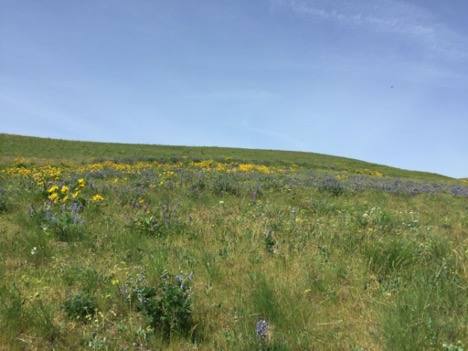
Monitoring Dalles Mountain Prairie’s response to grazing and wildfire
By Soledad Diaz and Denise Giles
February 2022
It was a sunny and windy May day as Denise and I met Bob Hansen - longtime friend of IAE (and former board member). With his usual welcoming smile, he was waiting for us with step ladders to climb over fences in dignified fashion. With abundant wildflowers framing our views of Mount Hood and the Columbia Gorge, we were constantly remarking on how lucky we were to be here on this beautiful day!
In 1993, part of the Dalles Mountain Ranch became the Columbia Hills Natural Area Preserve, administered by Washington Department of Natural Resources, and Dalles Mountain State Park, administered by Washington State Parks. In 2003 WSP combined Horsethief Lake and Dalles Mountain into the Columbia Hills State Park which spans over more than 3,000 acres (Figure 1).
Since 2016, IAE has been monitoring prairie habitat here to assess the long-term responses to management treatments and wildfire.
The Dalles Mountain Prairie is divided into five areas; in each we evaluate the status of the native plant communities along permanently established transects and plots. Each area has a unique history, including cattle grazing and wildfire. Even today, carefully managed grazing is used to manage these prairie habitats. A wildfire in 2015 crossed through some of the meadows and even burned portions of the monitoring transects.
In the past, much of the area was seeded with a cultivar of a native species (un)affectionately called “Secar” (Elymus wawawaiensis; Click here for more information on Secar Snake River Wheatgrass). Unfortunately, this ‘native’ cultivar turned out not to behave so much like the native grass it was meant to replenish, and deep, thick layers of thatch formed in a near monoculture – inhibiting the establishment of other native grasses and forbs.
The good news? Based on our 2021 monitoring, introduced species (including Secar) seem to be lower in the grazed areas, leaving more space for native grasses and forbs. Secar is also lower in abundance in the areas that have been grazed following the 2015 fire. We will continue to monitor the Dalles Mountain Prairie, but our results suggest that carefully controlled grazing has the potential to reduce invasive species cover and maintain a more diverse plant community.
This project involves many partners, from local to federal land management agencies, educational institutions, local ranchers, and native plant aficionados like Bob. IAE is grateful to be part of such a project and to work with so many partners to contribute to native habitat restoration efforts!
Restoration
Research
Education
Contact
Main Office:
4950 SW Hout Street
Corvallis, OR 97333-9598
541-753-3099
info@appliedeco.org
Southwest Office:
1202 Parkway Dr. Suite B
Santa Fe, NM 87507
(505) 490-4910
swprogram@appliedeco.org
© 2025 Institute for Applied Ecology | Privacy Policy

